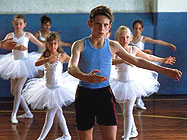|
|
|
|
Billy
Elliot
|
 |
|
There was, at the beginning of the new millennium, a sudden crowd of movies about low and high dancing: Billy Elliot from the UK and Center Stage (2000) from America, as well as two Australian films, Dein Perry's Bootmen (2000) and Lynda Heys' Kick (1999). Musicals that not only feature dance but actively explore it as a subject (by centring on auditions, training, benefit concerts, comeback performances, and the like) tend to select between a small number of dramatic or comic premises. The stories are often about the discovery of the dancing vocation – the case for the young boy (played by Jamie Bell) in Billy Elliot – or the refinding of that lost vocation, as much for Sean (Adam Garcia) in Bootmen and Matt (Russell Page) in Kick as for Astaire in Vincente Minnelli's classic The Band Wagon (1953). Once the initial will to dance has been acknowledged by the hero, other, larger obstacles start to complicate the dream: class conflicts (the working class men in Bootmen and Billy Elliot regard dancing as a bourgeois affectation); changing cultural styles (virtually all modern dance films make the obligatory, respectful, awestruck nod to Astaire and Ginger Rogers in Top Hat [1935], but Sean in Bootmen realises the need to go beyond that model and be 'modern'); technological challenges (Sean, like Gregory Hines in Nick Castle's wonderful Tap [1989], makes his breakthrough by finding a way to electronically amplify tap shoes); and that ever-present split between the 'high' and 'low' arts of dance, which few films manage to mend satisfactorily, although most fitfully try. Above all, dance movies like to explore issues of sexual identity, and the influence of family. Bootmen, Kick and Billy Elliot all deal with the taint of gayness that attaches itself to a man who chooses to dance for a living (Perry's film seems even uptight or defensive on this point). All these heroes struggle with the problem of having an overly stern father and a deceased mother – although (as in Strictly Ballroom and Billy Elliot) grandmothers who still possess the soul of rhythm come in handy as nurturing, maternal figures and plot resolvers. Many contemporary dance films, even those with the best intentions and citations, have lost the secret of animating rhythm (for that, we need to open our eyes to the still flourishing traditions of Hindi and Egyptian musicals). Too often, today, numbers simply start and end, rather than building up and dying away. Those movies that lead up to a big showbiz finale often seem suddenly scared of boring us, and so whisk the song and dance action away after a cascade of edited highlights – which happens in both Billy Elliot and Bootmen. Most damaging of all is the adoption of a widespread, MTV-derived editing and post-production technique. No longer are the dancers' gestures allowed to work in a synchronous, dynamic, unified way with the music, the moving camera and a precise, pre-visualised sequence of edit points. Rather, the dance is reduced to a random bunch of pictorial flourishes or swirls (slowed down, speeded up, shot from half a dozen angles and then frantically intercut), and the editing takes its cue from the metronomic beat of the music – which, for all its technologised splendour, seems awfully removed from the real space in which the dancers move and interact. Strictly Ballroom, Bootmen, Kick and Billy Elliot all fall prey to this terrible stylistic temptation; it's certainly fun to hear rousing pop tracks like John Paul Young's "Love is in the Air" (Strictly Ballroom) or T-Rex's "Ride a White Swan" (Billy Elliot) yoked to a story of dance – but where is that truly exciting, intricate fusion of sound and image? © Adrian Martin 2000 |
![]()